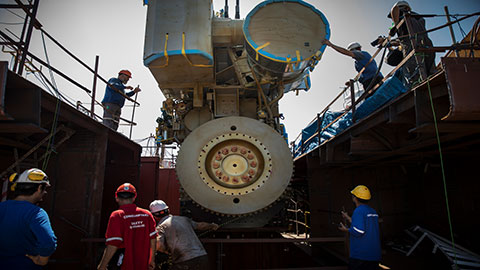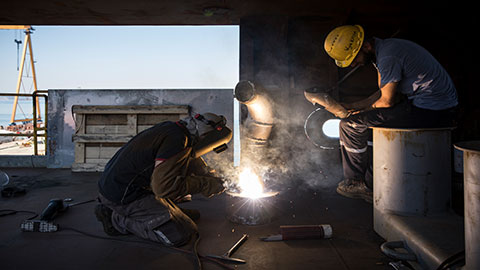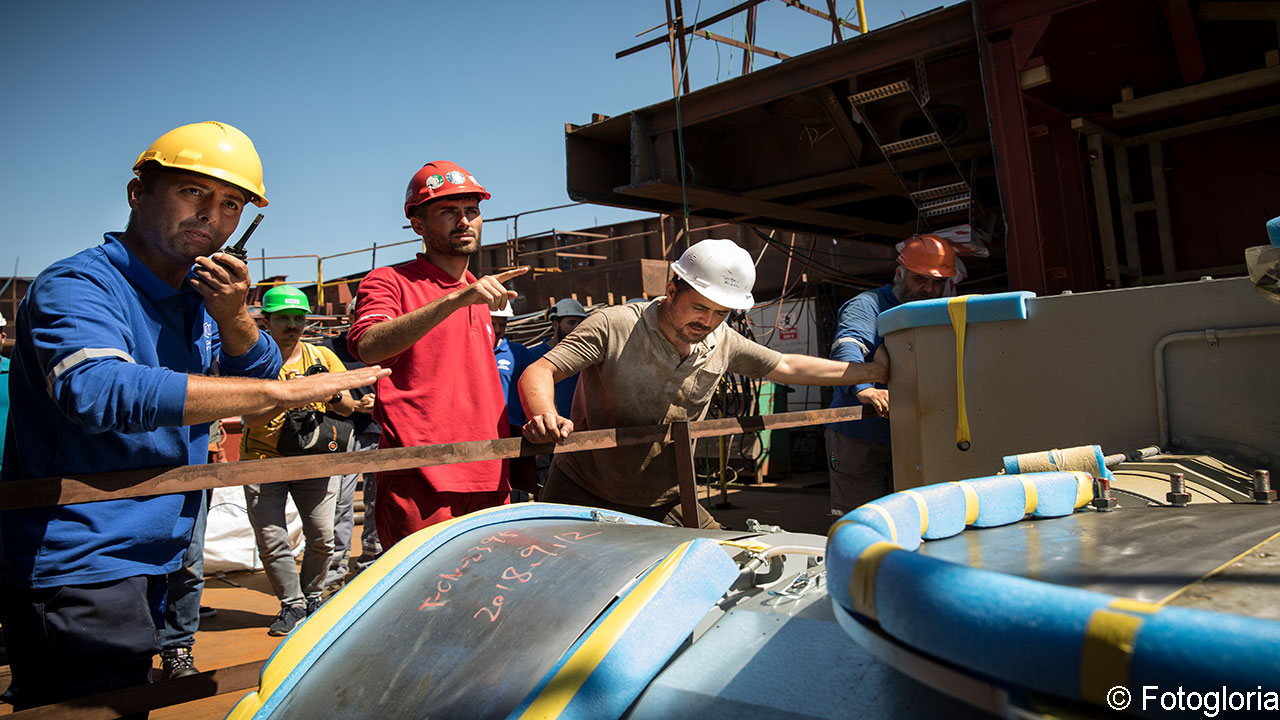LNG-fired dual-fuel engine powers fishing trawler to reduce NOx and carbon footprint
Anyone who has ever lived on a busy waterway knows about the environmental effects caused by ships. Although their share of global CO2 emissions is just around 3 percent, in times shaped by the climate crisis, the reputation of the marine industry among environmentalists is still poor. However, there is a responsibility to reduce the environmental impact as much as possible – and the Norwegian company Liegruppen could not agree more. This is why Liegruppen is the first fishing company to build a trawler powered by liquefied natural gas (LNG).
by Inga Rogg

The heart of the vessel: The propulsion system runs mainly on LNG.
A vessel built for the climate and the future
Liegruppen, which is run by the eponymous family, has garnered a reputation for its innovative spirit and its state-of-the-art vessels. “Every time we build a new ship, we combine tradition and innovation,” says Ole Christer Lie, captain of the new fishing trawler Libas, with noticeable pride. “And with all the focus that’s been on climate change over the past years, we felt it was only natural to assess the options of building an LNG vessel when we were planning a new ship. We think it’s a good vessel, built for the future.”
The decision for an LNG-operated fishing trawler was taken two years ago. The vessel was designed by Salt Ship Design and built by Cemre Shipyard in Istanbul. “MAN Energy Solutions was deliberately selected as the engine supplier,” says Lie. “In our opinion, they offered the solution that best fitted our needs”
As one of the market leaders in the field of dual-fuel propulsion systems, i.e. engines that run on both liquid natural gas (LNG) and diesel, MAN Energy Solutions had developed a completely new propulsion system, featuring a main engine, a MAN 6L51/60DF, a Renk gearbox, a MAN Alpha propeller system and a MAN Cyro LNG fuel gas system with a 350 m3 tank.
Trawler captain meets propulsion engineer
“What’s really interesting about this project is that it’s a fishing trawler,” explains Hendrik Pöpping, Head of Order Management at MAN Energy Solutions. “As an outsider, you wouldn’t necessarily expect the fishing industry to spearhead environmental protection. But it actually does.”
For this project, two kindred spirits found each other: one a fleet operator who happens to also be the captain of his own trawler and therefore knows exactly what he needs in terms of quality, and the other an engineer, who thrives on tricky assignments. And applying the latest technology to equip a fishing trawler definitely falls into the tricky category.
Lie and Pöpping agree that the biggest challenge was the space. In order to accommodate the large LNG tank, which had to be additionally insulated, and the associated equipment and still have sufficient space for the fish tanks, the ship had to be constructed larger than usual. It now has a length of 85 meters, which is almost 20 meters longer than its older siblings in the Liegruppen fleet.

Teamwork on the new trawler Libas at the Cemre Shipyard in Turkey.
Best efficiency and load changes
In addition, the way a fishing trawler operates places special demands on the engine. In contrast to a power station, for example, where an engine would run at the same load for prolonged periods of time, the engine of a fish trawler has to be able to adjust well to constantly varying loads. For diesel engines, this is no problem.
“When you design a gas-fired engine you are typically looking to increase the efficiency. But, it’s difficult for a gas engine to cope with load changes because the operating window becomes smaller with increased efficiency,” says Pöpping. “However, we created a clever design to overcome this challenge and this engine type now combines the best of both worlds: It performs well in terms of efficiency and is also very robust in accepting load changes.”
As a result, even if the captain performs port maneuvers, the engine does not fall back into diesel mode but runs on liquid gas. The new trawler is designed to run primarily on gas, says Pöpping. “It is therefore very, very environmentally friendly.” According to MAN, the ecological gain is enormous. Natural gas burns almost particle- and sulfur oxide (SOx)-free and the nitrogen oxide (NOX) emissions are projected to be reduced by approximately 80 percent. The estimated CO2 saving is 24 percent.

Flagship project leads the way for environmentally friendly propulsion
So why has the fishing industry waited so long for this innovation? Pöpping sees the chicken and egg principle at work here. For a long time, there had been no comprehensive infrastructure to store LNG. In addition, the use of liquid gas is relatively expensive because of the additional costs for safe storage.
However, in recent years there has been a change. There has been investment on a national level with major ports greatly expanding the infrastructure for LNG. “We are discussing bans on diesel driving in cities,” says Pöpping. “So it’s time for the shipping industry to follow suit. This is why a flagship project like the Libas is so impactful. It is a herald of the change to come.”
But reducing a vessel’s ecological footprint comes at a price. The LNG-powered trawler cost Liegruppen about 30 percent more than a boat with a conventional engine. In addition, there are the costs of training the twenty sailors. “But we think it’s worth it,” says Ole Christer Lie. “We have a responsibility towards the environment, and we are fully prepared to assume that responsibility.”
“We are discussing bans on diesel driving in cities – so it’s time for the shipping industry to follow suit.”
About the author
Inga Rogg has worked as a Middle East correspondent for many years. She is based in Istanbul and has first-hand experience of living on one of the world’s busiest waterways, the Bosporus.
Explore more topics
MAN Energy Solutions is now Everllence.
We have adopted a new brand name and moved to a new domain: www.everllence.com. This page will also be relocated there shortly. We are working on shifting all pages to www.everllence.com.
